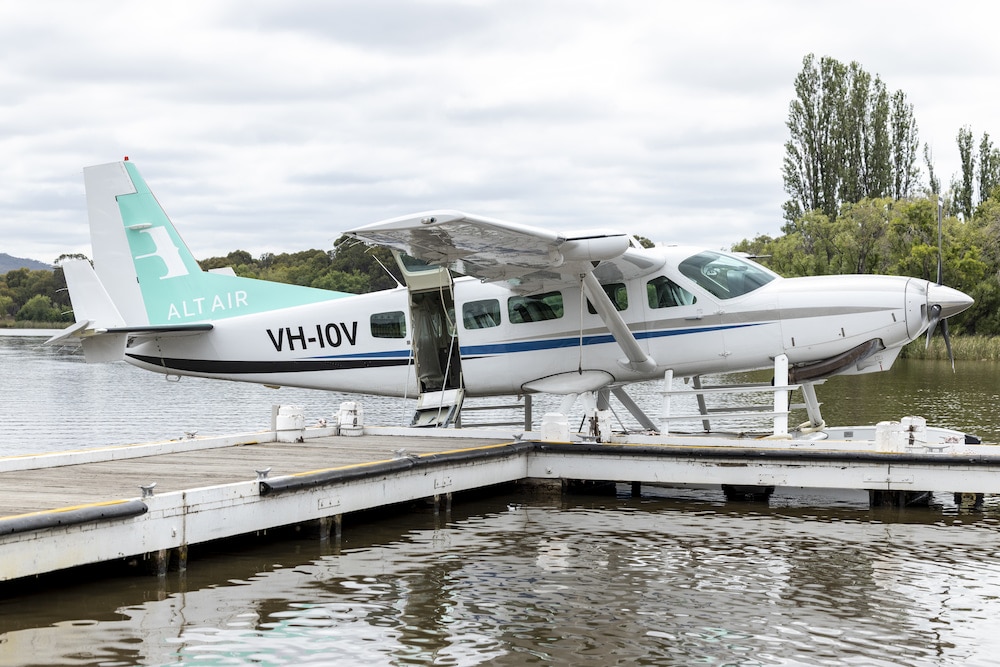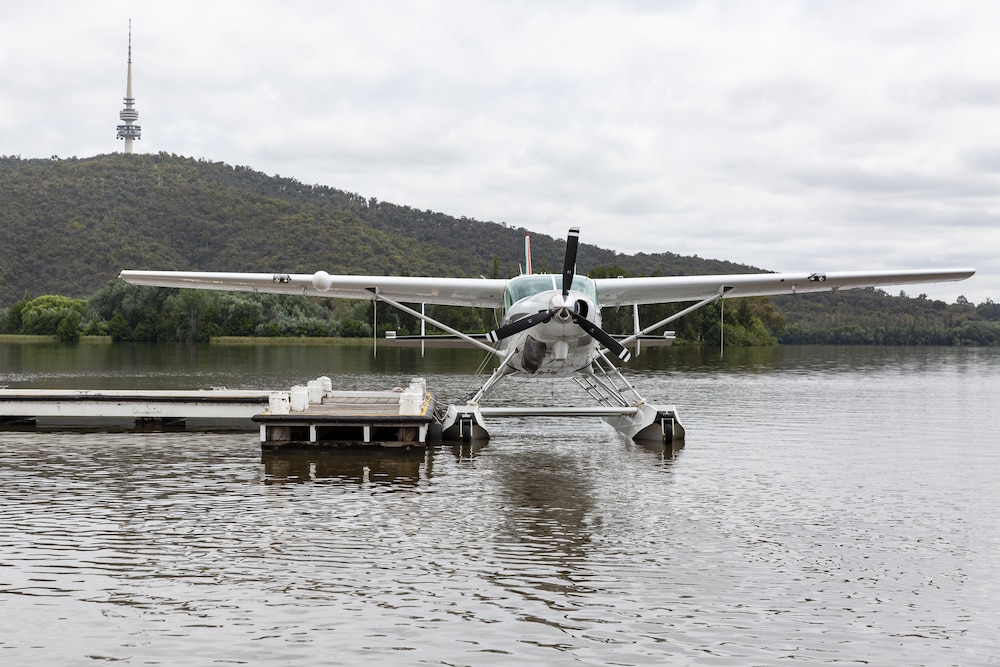Last week, the National Capital Authority (NCA) approved Lake Burley Griffin as a landing spot for seaplanes from Sydney and the NSW south coast, despite community opposition.
Sydney Seaplanes, the largest seaplane operator in Australia, intends to fly between the Lake and Rose Bay, Sydney (at 10am and 4pm), and between Canberra Airport and Sydney (mornings and evenings). South Coast Seaplanes would offer scenic tours of the Lake, and fly between Canberra and the south coast twice a week.
A proposal for seaplanes to use the lake was first put to the Canberra community for feedback in May. Of 102 public submissions, 72 opposed the proposal, and only 21 were in favour. Eight were neutral or mixed, and six thought more advice or information was required.
The Lake Burley Griffin Guardians claimed the NCA’s decision to approve seaplanes in face of public opposition was “shockingly premature and an abrogation of its responsibilities”.
The NCA determined the tourism benefits would outweigh any potential impacts of the seaplanes.
“As always, the NCA must focus on Canberra as the National Capital being a place for all Australians, while addressing the legitimate and well considered concerns of the local community and users of the public realm,” a spokesperson said.
Aaron Shaw, Sydney Seaplanes’ CEO, said he was “absolutely delighted” with the NCA approval; they had been in detailed discussions with the agency for two years, including a demonstration flight last year. (In fact, the company had been interested in the concept for 15 years; the idea was first mooted in 2007.)
Mr Shaw believes the Canberra to Sydney flight will be “one of the world’s great seaplane services, connecting our nation’s capital with our largest city, and from the centre of both”.
Canberrans will be able to access the centre of Sydney in an hour, without the time and hassle of flying from airport to airport, “where you have lots of different queues, hassles, crowds, delays, taxiing”. That inconvenience deters travellers; of 11 million passenger journeys pre-COVID between Sydney and Canberra, only 1 million passengers flew.
“Once we start these flights, they will be available to all Canberrans; they’re going to be reasonably priced; and they’re going to provide incredible access on a beautiful flight to the centre of Sydney, so that will be a huge benefit to the people of Canberra for many years to come.”

Seaplanes will be good for tourism
Proponents argue the route could be one of the world’s great seaplane services, cutting the hassle of airport-to-airport travel, and offering a new and exciting tourism opportunity to benefit the ACT economy.
Chief Minister Andrew Barr endorsed the idea; the ACT Government believes seaplanes to Canberra would provide a new tourism offering to the city, and a point of differentiation to market Canberra to international visitors as tourism returns.
Dr David Marshall AM, chair of the Canberra Region Tourism Leaders Forum, believes that seaplanes would be a very good profile builder for the ACT.
“It’s different, it’ll attract high yield passengers – both businesspeople and tourists – into the ACT,” he said.
Seaplanes, Dr Marshall continued, were a different product offering that would “fit beautifully into the already well-established tourism opportunities that Canberra provides”. National attractions like the National Museum could piggyback and package the product: tourists could fly directly to the Museum, visit an exhibition, have lunch at Regatta Point, then return to Sydney or the south coast.
“This experience, I think, would be outstanding for any visitor – a fabulous day out,” Dr Marshall said. “International visitors coming into Sydney or even the south coast have money, and they’re not afraid to spend it.”
Sydney Seaplanes already partnered with Sydney and Hunter Valley tourism and leisure businesses to offer packages that included accommodation, restaurants, and tours. Mr Shaw wanted to extend that concept onto the Canberra–Sydney service, and partner with ACT businesses.
Seaplanes were also a good way to generate more activity around and on the Lake, Dr Marshall thought. “From a tourism point of view, we need to utilise the Lake more,” he said.
“When it starts, I think people will be very warm to the idea that we can bring people into Canberra; they’ll have a magnificent flight down from Sydney or the South Coast, and it’s not going to impose a lot of inconvenience on people at all whatsoever. It shouldn’t. And I think it will enhance the product offering that the city so desperately needs as it continues to grow its tourism products.”
But could seaplanes interfere with local sports?
Lake Burley Griffin is also a popular yachting, windsailing, and rowing spot, and swimmers also brave some areas. Opponents of the proposal, like the Lake Burley Griffin Guardians and the Canberra Yacht Club, worry seaplanes will endanger lake users, make lake-based sporting clubs unviable, and that noise and pollution would ruin the peace and quiet of the lake.
“The introduction of seaplanes will have a significant impact on other Lake users and the environment,” the Lake Burley Griffin Guardians said in a press release. “The NCA seems to be focused on the narrow commercial benefits to a few mostly interstate tourism operators and their affluent customers.”
In their press release, they objected to the NCA provisionally approving seaplanes on the Lake based on one demonstration flight and before details of the proposal and its viability had been released to the public.
Seaplanes, they argued, represent a major change in the role and function of the Lake, but, they claimed, the NCA had not carried out any detailed analyses of the proposal, such as environmental and heritage impact statements, or a cost benefit analysis.
In its submission, the Canberra Yacht Club, one of the city’s oldest sporting and community clubs, believed seaplanes threatened their operations, safety, and financial viability, and hence their continued existence. The NCA has given approval for the seaplanes to use West Basin; the CYC would prefer the seaplanes to operate from Central Basin instead.
The NCA acknowledged the safety concerns raised by community groups; a spokesperson said the agency had considered all issues raised through the public consultation process, and that the potential impacts of seaplane operations on Lake Burley Griffin could be appropriately managed.
“Seaplane operations should not compromise the safe and shared use of Lake Burley Griffin,” the NCA agreed.
The NCA has invited several lake user groups to help prepare guidelines for the shared and safe use of Lake Burley Griffin. Work will begin in February.
Mr Shaw said the seaplanes’ impact on the lake would be “very minimal”. With only two flights per day – five minutes landing, five minutes take-off each time – the seaplane would only interact with the lake for 20 minutes. The take-off run is short, around 500 metres.
Both Sydney Seaplanes and South Coast Seaplanes were used to operating in busy waterways: Rose Bay (the busiest waterway in the country) is used by ferries, kayakers, pleasure boats, sailing clubs, and rowing clubs, and Moruya River is more constrained than Lake Burley Griffin.
“Two flights to Lake Burley Griffin is something that we anticipate that we’ll be able to work very well with most other users of the lake,” Mr Shaw said.
In practice, seaplanes would not affect water users or birdlife, South Coast Seaplanes’ Tim Gilbo told ABC Radio in May.
“Seaplanes are very rare in Australia, unlike in Canada and Alaska, … so understandably people don’t know much about their operations,” he said. “In general, people are used to aircraft being big, dangerous things behind fences on airports … but on the whole what we do is pretty simple.”
Mr Gilbo looked forward to working with the NCA on any further work that would be required to approve seaplane operations on the Lake.
In terms of pollution, Sydney Seaplanes plans to become the world’s first all-electric and zero-emissions airline by 2025. They are part of a company called Dovetail Electric Aviation, which retrofits aircraft with electric engines, driven by batteries or hydrogen cells.
“Those aircraft produce no emissions in flight at all,” Mr Shaw said.
Sydney Seaplanes would work with other lake users, the NCA, and other regulators to make sure there was a clearly defined plan to how and where they would operate. As part of their demonstration flight last year, Sydney Seaplanes had worked out a plan, including a risk assessment and clear guidelines.
That plan would be put out on a more public and consultative basis, so everyone understands how and where the planes operated, and what approach paths they used in different wind conditions, so that nothing came as a surprise to any of the other users on the lake.
“We really are looking forward to working with those other users of the lake over the next few months before any services start to operate,” Mr Shaw said. “We hope to ensure that everyone is more comfortable with what we’re proposing, which is only two flights a day, and that we can then safely work together to share the lake.”
- With AAP
Get all the latest Canberra news, sport, entertainment, lifestyle, competitions and more delivered straight to your inbox with the Canberra Daily Daily Newsletter. Sign up here.



